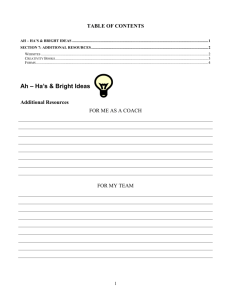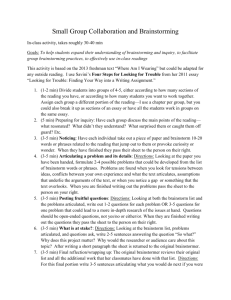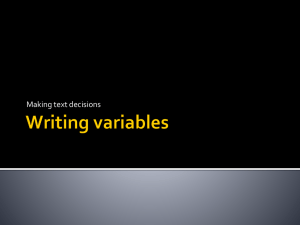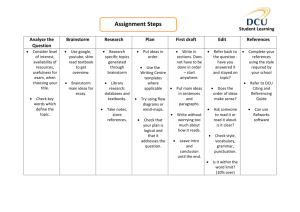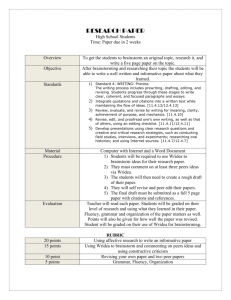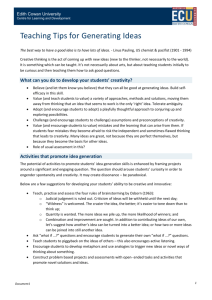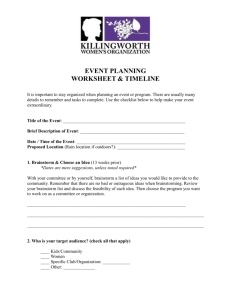Strategy 1. Verbal Brainstorming
advertisement
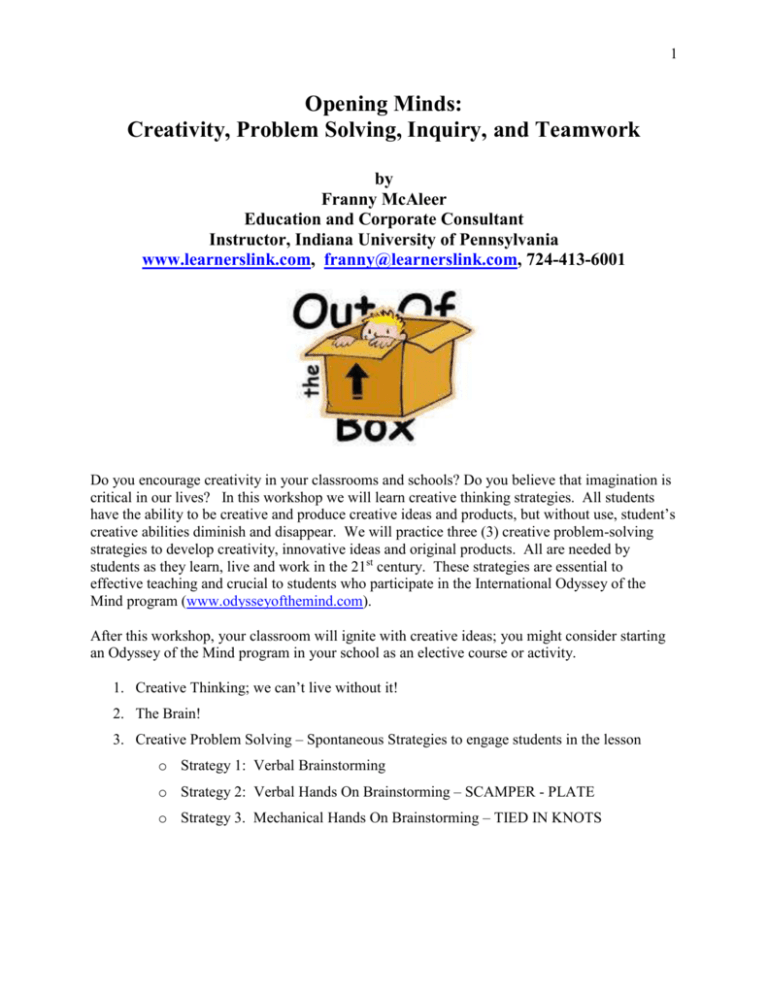
1 Opening Minds: Creativity, Problem Solving, Inquiry, and Teamwork by Franny McAleer Education and Corporate Consultant Instructor, Indiana University of Pennsylvania www.learnerslink.com, franny@learnerslink.com, 724-413-6001 Do you encourage creativity in your classrooms and schools? Do you believe that imagination is critical in our lives? In this workshop we will learn creative thinking strategies. All students have the ability to be creative and produce creative ideas and products, but without use, student’s creative abilities diminish and disappear. We will practice three (3) creative problem-solving strategies to develop creativity, innovative ideas and original products. All are needed by students as they learn, live and work in the 21st century. These strategies are essential to effective teaching and crucial to students who participate in the International Odyssey of the Mind program (www.odysseyofthemind.com). After this workshop, your classroom will ignite with creative ideas; you might consider starting an Odyssey of the Mind program in your school as an elective course or activity. 1. Creative Thinking; we can’t live without it! 2. The Brain! 3. Creative Problem Solving – Spontaneous Strategies to engage students in the lesson o Strategy 1: Verbal Brainstorming o Strategy 2: Verbal Hands On Brainstorming – SCAMPER - PLATE o Strategy 3. Mechanical Hands On Brainstorming – TIED IN KNOTS 2 Strategy 1. Verbal Brainstorming- Select an essential vocabulary word or concept related to the lesson or curriculum and ask students to brainstorm possible ideas related to it. For example: Brainstorm things that are blue! Brainstorm things that slither! More ideas at www.learnerslink.com www.odysseyofthemind.com Strategy 2: Hands On Brainstorming – Select an object related to your lesson or curriculum and have students brainstorm possibilities! Example: How many things can you do with a plate? More ideas at www.learnerslink.com www.odysseyofthemind.com 3 Strategy 3. Hands On, Collaborative Problems to Solve (Teamwork) *Fortune 500 Companies agree that the number one skill they want their workers to have is TEAMWORK! 1. Tied In Knots 2. Two Horses, How Many Ways? 3. A Project of Monumental Proportion 4. River Rescue 4 Odyssey of the Mind Curriculum Activities http://www.odysseyofthemind.com/curriculum.php Digging for Clues Extend-sive Thinking Playing the Float Shape Shifter Understanding Misunderstandings Balance the Books From a Distance Healthy Humor Making of a Monster My robot and me Second Time Around Story Structure Fantastic Fairy Tale Great to Communicate Made up Math Mathematicus Dramaticus Performing Arts Sentence Structure Up to Speed 5 Creativity: The Skills, An Essential Process FFOE: Fluency, Flexibility, Originality, and Elaboration Fluent Thinking Quantity, Large number of relevant responses Flexible Thinking Variety of kinds of ideas, Ability to shift categories Original Thinking Unusual responses, Clever, Novel ideas Zany Elaborative Thinking Embellish an idea or expand it, add details *********************************** Risk Taking Willingness to expose oneself to failure or criticism Complexity Seek many alternatives. See gaps Be inquisitive and wonder Curiosity Be open to puzzling situations. Ponder the mystery of things. Follow a hunch just to see what will happen Imagination Visualize and build mental images. Dream about things that never happened 6 SCAMPERing … The Keys to Creativity Substitute – Who else instead? What else instead? Other ingredients? Other materials? Other power? Other place? Combine – How about a blend, an alloy, an ensemble? Combine purposes? Combine appeals? Adapt – What else is like this? What other idea does this suggest? Does the past offer parallels? What could I borrow from someplace else? Modify – Minify, Magnify, Maxify? Order, form, shape? What to reduce? Greater frequency? Higher? Larger? Thicker? Put to Other Uses – New ways to use as it is? Other uses if modified? Other places to use? Other people to reach? Other uses for those who are not human? Other uses for animals? Eliminate – What to subtract? Smaller? Condensed? Miniature? Lower? Shorter? Lighter? Omit? Streamline? Understate? Reverse or Rearrange – Interchange components? Other pattern? Other layout? Other sequence? Transpose cause and effect? Change pace? Transpose positive and negative? How about opposites? Turn it backward? Turn it upside down? Reverse roles?

